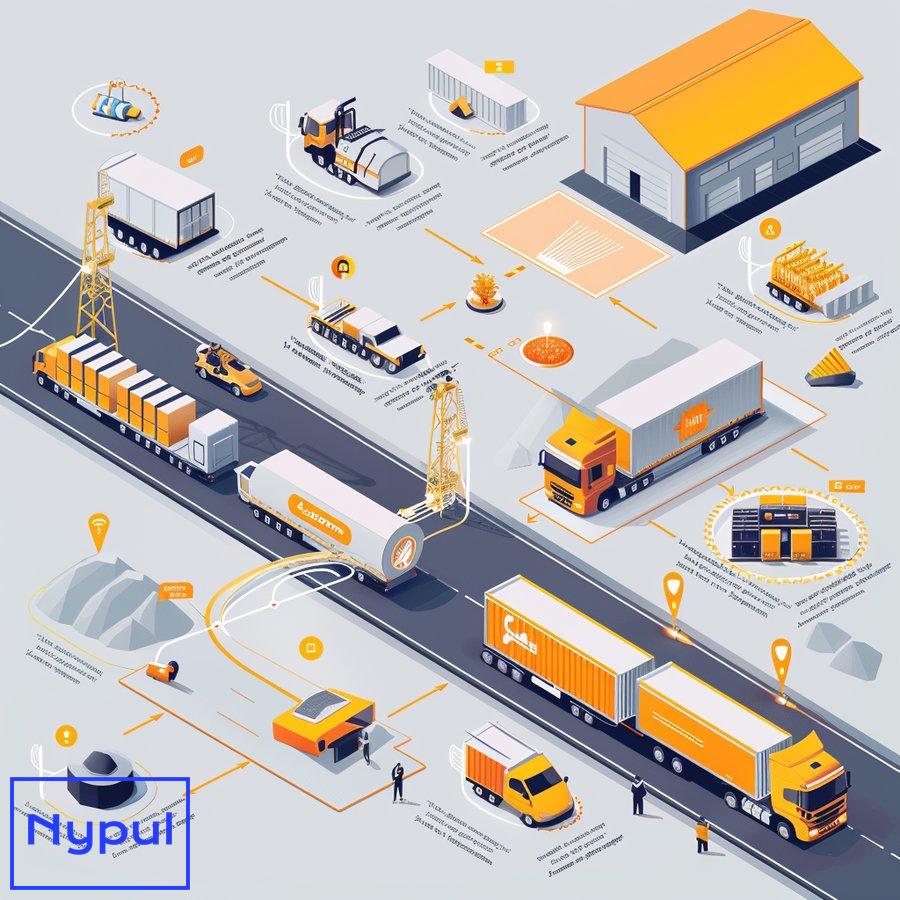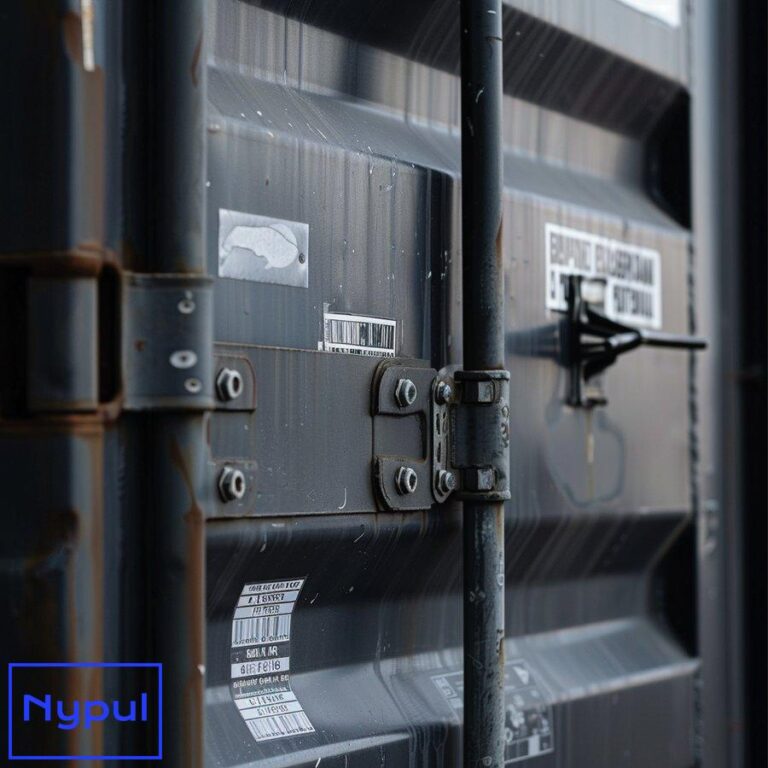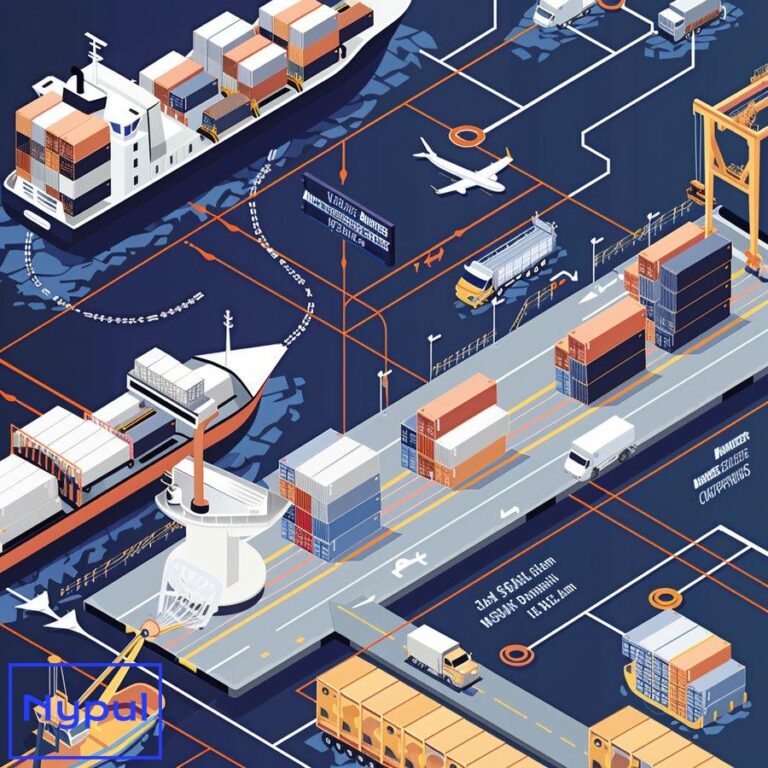What Are Drayage Loads
Drayage loads refer to the short-distance transportation of shipping containers or cargo, typically within a single metropolitan area. These loads form a crucial link in the intermodal freight transportation system, connecting different modes of long-distance transport such as ships, trains, and trucks.
The term “drayage” originates from the word “dray,” which historically referred to a low, sturdy cart used for hauling heavy loads over short distances. In modern logistics, drayage loads have evolved to encompass the movement of containerized cargo between ports, rail terminals, and distribution centers.
Drayage loads are characterized by several key features:
Short distance: Drayage typically involves transporting goods over distances of less than 100 miles, often within the same urban area or region.
Intermodal connectivity: These loads bridge the gap between different modes of transportation, facilitating the seamless transfer of cargo from one carrier to another.
Time-sensitive: Drayage operations are often time-critical, as they need to align with the schedules of ships, trains, and long-haul trucks.
Container-focused: Most drayage loads involve the movement of standardized shipping containers, which can be easily transferred between different modes of transport.
To better understand the scope of drayage loads, consider the following table outlining common drayage scenarios:
| Scenario | Description | Example |
|---|---|---|
| Port drayage | Moving containers from a seaport to a nearby rail terminal or distribution center | Transporting a container of electronics from the Port of Los Angeles to a rail yard 20 miles inland |
| Rail drayage | Transferring containers between rail terminals and local warehouses or distribution centers | Moving a container of auto parts from a Chicago rail terminal to a nearby automotive factory |
| Shuttle drayage | Relocating containers within a port or terminal complex to manage congestion or storage issues | Shifting containers from an overcrowded storage area to a temporary holding lot within the same port |
| Door-to-door drayage | Delivering containers directly from a port or terminal to the end customer’s location | Transporting a container of furniture from a New York port to a retail store in New Jersey |
Understanding drayage loads is essential for logistics professionals, supply chain managers, and businesses involved in international trade. These short-haul movements play a vital role in ensuring the efficient flow of goods from global suppliers to local markets, acting as the connective tissue that holds the complex web of modern logistics together.
For shippers and freight forwarders, recognizing the importance of drayage loads allows for better planning and coordination of shipments. By factoring in drayage operations, they can more accurately estimate transit times, manage costs, and ensure smooth handoffs between different transportation modes.
Carriers and trucking companies specializing in drayage operations face unique challenges and opportunities. The short-haul nature of these loads requires a different operational approach compared to long-distance trucking, with a focus on quick turnarounds, local knowledge, and efficient coordination with port and terminal operations.
As global trade continues to grow and supply chains become increasingly complex, the role of drayage loads in facilitating the movement of goods is likely to become even more critical. Stakeholders across the logistics industry must stay informed about drayage operations to optimize their supply chain strategies and maintain a competitive edge in the fast-paced world of international commerce.
How do drayage loads fit into the supply chain?
Drayage loads serve as a critical component in the intricate web of global supply chains, acting as the connective tissue between major transportation hubs and local distribution networks. Understanding their role is essential for supply chain managers, logistics professionals, and businesses engaged in international trade.

Bridging transportation modes
Drayage loads primarily function as a bridge between different modes of long-distance transportation. They facilitate the seamless transfer of cargo between:
Ocean freight and land transport: When a container ship arrives at a port, drayage services move the containers to rail yards or trucking terminals for further distribution.
Rail and road transport: Drayage trucks transport containers from rail terminals to local warehouses or distribution centers, completing the last leg of the journey.
Air freight and ground transportation: For time-sensitive cargo arriving by air, drayage services ensure quick transfer to local delivery networks.
This intermodal connectivity allows for the efficient movement of goods across vast distances, combining the strengths of each transportation mode to optimize the supply chain.
Last-mile connectivity
In many cases, drayage loads represent the final step in bringing goods from global suppliers to local markets. This last-mile connectivity is crucial for:
Retailers: Ensuring timely restocking of inventory from regional distribution centers.
Manufacturers: Receiving raw materials or components from international suppliers.
E-commerce businesses: Facilitating rapid order fulfillment from local warehouses.
By providing this vital link, drayage operations enable businesses to maintain lean inventories and respond quickly to market demands.
Supply chain flexibility
Drayage loads introduce an element of flexibility into supply chains by:
Buffering against disruptions: When issues arise at ports or rail terminals, drayage services can quickly reroute containers to alternative facilities, minimizing delays.
Enabling cross-docking: Drayage operations support cross-docking strategies, where goods are transferred directly from inbound to outbound transportation with minimal storage time.
Supporting just-in-time inventory: The ability to move small batches of goods quickly allows businesses to implement just-in-time inventory systems, reducing storage costs and improving cash flow.
This flexibility is particularly valuable in today’s dynamic business environment, where supply chains must adapt to rapidly changing market conditions.
Cost optimization
While drayage represents a relatively small portion of the overall transportation distance, it can significantly impact supply chain costs. Efficient drayage operations contribute to cost optimization by:
Reducing demurrage and detention fees: Timely movement of containers from ports and terminals helps avoid costly storage and late return charges.
Minimizing inventory holding costs: Quick transfer of goods to their final destinations reduces the need for intermediate storage and associated expenses.
Enabling modal shifts: Drayage allows shippers to choose the most cost-effective combination of transportation modes for each leg of the journey.
To illustrate the impact of drayage on supply chain costs, consider the following table:
| Cost Factor | Without Efficient Drayage | With Efficient Drayage |
|---|---|---|
| Demurrage fees | $200 per container per day | $0 (containers moved within free time) |
| Inventory holding costs | 2% of goods value per month | 0.5% of goods value per month |
| Modal flexibility | Limited to single mode | Optimized multimodal options |
| Total logistics costs | 15% of goods value | 10% of goods value |
Supply chain visibility
Drayage operations play a crucial role in maintaining visibility throughout the supply chain:
Real-time tracking: Modern drayage services often provide real-time tracking of container movements, offering valuable data for supply chain managers.
Customs clearance coordination: Drayage providers frequently assist with customs documentation and clearance processes, ensuring smooth transitions between international and domestic legs of the journey.
Exception management: The short-haul nature of drayage allows for quick responses to unexpected events or changes in shipment plans.
This enhanced visibility enables better decision-making and proactive problem-solving throughout the supply chain.
Environmental considerations
As sustainability becomes an increasingly important factor in supply chain management, drayage operations are evolving to address environmental concerns:
Clean truck programs: Many ports and terminals are implementing clean truck programs, requiring drayage vehicles to meet specific emissions standards.
Electrification initiatives: Some drayage fleets are transitioning to electric vehicles for short-haul operations, reducing carbon emissions and noise pollution.
Optimization of routes and loads: Advanced logistics software helps minimize empty miles and maximize load efficiency, reducing the overall environmental impact of drayage operations.
These initiatives not only contribute to corporate sustainability goals but also help comply with increasingly stringent environmental regulations in many regions.
For supply chain professionals, understanding the multifaceted role of drayage loads is essential for optimizing overall logistics operations. By recognizing drayage as a critical link in the supply chain, managers can:
- Improve coordination between different transportation modes
- Enhance responsiveness to market demands
- Reduce overall logistics costs
- Increase supply chain visibility and control
- Contribute to sustainability initiatives
As global trade continues to evolve, the importance of efficient drayage operations in supporting agile and resilient supply chains is likely to grow. Supply chain managers who master the intricacies of drayage loads will be better positioned to navigate the complexities of modern logistics and drive competitive advantage for their organizations.
What are the different types of drayage loads?
Drayage loads come in various forms, each serving specific purposes within the supply chain. Understanding these different types is crucial for logistics professionals, freight forwarders, and businesses involved in international trade. Let’s explore the main categories of drayage loads and their unique characteristics.
![]()
1. Port drayage
Port drayage involves the movement of containers between seaports and nearby facilities such as rail terminals, distribution centers, or local warehouses. This type of drayage is critical for:
Import operations: Moving containers from ships to inland destinations.
Export operations: Transporting goods from local facilities to ports for international shipping.
Transshipment: Transferring containers between different vessels at the same port.
Port drayage operations often face challenges such as port congestion, customs clearance procedures, and coordination with vessel schedules.
2. Rail drayage
Rail drayage focuses on the transportation of containers between rail terminals and local destinations. This type includes:
Rail-to-truck transfers: Moving containers from rail cars to trucks for final delivery.
Truck-to-rail transfers: Bringing containers from local shippers to rail terminals for long-distance transport.
Inter-terminal transfers: Shifting containers between different rail terminals within the same metropolitan area.
Rail drayage requires close coordination with rail schedules and often involves specialized equipment for handling intermodal containers.
3. Shuttle drayage
Shuttle drayage involves the short-distance movement of containers within a single facility or between nearby locations. Common scenarios include:
Terminal repositioning: Moving containers between different areas of a port or rail terminal to manage space and optimize operations.
Overflow management: Transferring containers to off-site storage facilities during peak periods.
Equipment balancing: Relocating empty containers to areas where they are needed for loading.
Shuttle drayage plays a crucial role in managing congestion and improving the overall efficiency of transportation hubs.
4. Expedited drayage
Expedited drayage services cater to time-sensitive shipments that require rapid movement between transportation modes. This type is essential for:
Just-in-time manufacturing: Delivering components to production facilities on tight schedules.
Perishable goods: Ensuring quick transfer of temperature-sensitive products.
High-value items: Minimizing the time high-value cargo spends in transit or storage.
Expedited drayage often involves dedicated trucks and prioritized handling to meet strict delivery deadlines.
5. Door-to-door drayage
Door-to-door drayage provides end-to-end container transportation services, typically from a port or rail terminal directly to the final recipient. This type of drayage is valuable for:
Retail deliveries: Bringing goods directly from ports to store locations.
Construction projects: Delivering materials from ports to construction sites.
Trade shows and events: Transporting exhibition materials from ports to convention centers.
Door-to-door drayage offers convenience and simplified logistics for recipients but may require additional coordination for delivery appointments and special handling requirements.
6. Cross-town drayage
Cross-town drayage involves moving containers between different carriers or modes of transportation within the same metropolitan area. This type facilitates:
Interline transfers: Moving containers between terminals of different railroad companies.
Mode shifts: Transferring cargo from air freight terminals to ground transportation or vice versa.
Carrier changes: Switching containers between different trucking companies for onward transportation.
Cross-town drayage requires knowledge of local traffic patterns and coordination between multiple transportation providers.
7. Pier drayage
Pier drayage specifically refers to the movement of containers between a marine terminal and a rail ramp within the same port complex. This type of drayage is crucial for:
On-dock rail operations: Facilitating direct transfer between ships and trains without intermediate truck transportation.
Near-dock rail facilities: Moving containers to nearby rail terminals for more efficient intermodal connections.
Pier drayage often involves short distances but requires precise timing to align with vessel and train schedules.
To better understand the characteristics and applications of these drayage types, consider the following comparison table:
| Drayage Type | Typical Distance | Key Features | Common Applications |
|---|---|---|---|
| Port drayage | 1-50 miles | Customs coordination, vessel schedule alignment | Import/export operations |
| Rail drayage | 1-100 miles | Intermodal equipment handling, rail schedule coordination | Long-distance freight distribution |
| Shuttle drayage | <5 miles | High-frequency moves, space management | Terminal operations, congestion relief |
| Expedited drayage | Varies | Time-critical, prioritized handling | Just-in-time manufacturing, perishables |
| Door-to-door drayage | 1-100 miles | End-to-end service, delivery appointments | Retail, construction, events |
| Cross-town drayage | 5-50 miles | Inter-carrier coordination, local traffic navigation | Interline transfers, mode shifts |
| Pier drayage | <5 miles | On-dock rail operations, port-centric logistics | Efficient intermodal connections |
For logistics professionals and businesses involved in international trade, understanding these different types of drayage loads is essential for:
- Selecting the most appropriate drayage services for specific shipment needs
- Anticipating potential challenges and bottlenecks in the supply chain
- Optimizing transportation costs and transit times
- Improving coordination between different modes of transportation
- Enhancing overall supply chain efficiency and reliability
By recognizing the unique characteristics and requirements of each drayage type, supply chain managers can make informed decisions about routing, carrier selection, and logistics planning. This knowledge enables the development of more resilient and adaptable supply chain strategies, capable of meeting the diverse needs of modern global trade.
As the logistics industry continues to evolve, new variations and hybrid forms of drayage may emerge to address specific market needs or technological advancements. Staying informed about these developments and understanding their potential impact on supply chain operations will be crucial for maintaining a competitive edge in the dynamic world of international logistics.
What equipment is used for drayage operations?
Drayage operations rely on a variety of specialized equipment to efficiently move containers and cargo over short distances. Understanding the tools and vehicles used in drayage is essential for logistics professionals, equipment managers, and businesses involved in intermodal transportation. Let’s explore the key equipment used in drayage operations and their specific applications.

Drayage trucks
Drayage trucks, also known as yard trucks or terminal tractors, are the workhorses of drayage operations. These vehicles are designed for short-haul transportation and frequent stops. Key features include:
Short wheelbase: Allows for better maneuverability in tight spaces.
Reinforced frame: Capable of handling heavy container loads.
Hydraulic fifth wheel: Enables quick coupling and uncoupling of trailers.
Elevated cab: Provides better visibility for drivers in congested port or terminal environments.
Drayage trucks come in various configurations, including day cabs for local operations and sleeper cabs for longer regional hauls.
Chassis
Chassis are the skeletal trailers used to transport shipping containers. They are essential components in drayage operations, with several types available:
Standard chassis: Designed for 20-foot, 40-foot, or 45-foot containers.
Extendable chassis: Can be adjusted to accommodate different container lengths.
Tri-axle chassis: Provides additional weight capacity for heavy loads.
Gooseneck chassis: Offers a lower deck height for oversized or high-cube containers.
Chassis management is a critical aspect of drayage operations, often involving complex logistics to ensure the right type of chassis is available when and where needed.
Container handling equipment
Efficient movement of containers within ports and terminals requires specialized handling equipment:
Reach stackers: Versatile machines used for stacking and moving containers in terminal yards.
Top loaders: Designed for quick loading and unloading of containers onto chassis or railcars.
Straddle carriers: Mobile gantry cranes that can lift and transport containers independently.
Empty container handlers: Specialized forklifts for managing empty containers in storage yards.
This equipment plays a crucial role in optimizing terminal operations and minimizing dwell times for drayage trucks.
Intermodal cranes
Cranes are essential for transferring containers between different modes of transportation:
Ship-to-shore cranes: Massive gantry cranes used to load and unload container ships.
Rail-mounted gantry cranes: Used in rail terminals for transferring containers between trainsand trucks.
Rubber-tired gantry cranes: These mobile cranes are used in container yards to stack and move containers efficiently.
Intermodal cranes are vital for maintaining the flow of containers between ships, trucks, and trains, ensuring that drayage operations can proceed smoothly and without delays.
Forklifts
Forklifts play a significant role in drayage operations, particularly in warehouses and distribution centers. They are used for:
Loading and unloading containers: Forklifts can lift containers from chassis or ground storage and place them in designated areas.
Moving cargo within facilities: They facilitate the efficient movement of goods within warehouses, ensuring that products are quickly accessible for shipping or storage.
Handling heavy loads: Specialized forklifts can handle heavy or oversized cargo that may not fit standard containers.
The versatility of forklifts makes them indispensable in drayage operations, allowing for quick and efficient handling of various types of cargo.
Technology in drayage equipment
Advancements in technology have led to the development of smart equipment that enhances the efficiency and safety of drayage operations:
Telematics systems: These systems provide real-time tracking and monitoring of vehicles, allowing fleet managers to optimize routes and improve operational efficiency.
Automated guided vehicles (AGVs): Used in some terminal operations, AGVs can autonomously transport containers between designated points, reducing labor costs and increasing efficiency.
Container positioning systems: These technologies help manage container storage and retrieval in terminal yards, minimizing dwell times and improving overall workflow.
Incorporating technology into drayage equipment enhances operational performance, reduces costs, and improves safety for workers involved in container handling.
To summarize the essential equipment used in drayage operations, consider the following table:
| Equipment Type | Purpose | Key Features |
|---|---|---|
| Drayage trucks | Transport containers over short distances | Short wheelbase, hydraulic fifth wheel |
| Chassis | Support shipping containers during transport | Standard, extendable, tri-axle designs |
| Container handling equipment | Move and stack containers within terminals | Reach stackers, top loaders, straddle carriers |
| Intermodal cranes | Transfer containers between transportation modes | Ship-to-shore cranes, rail-mounted gantry cranes |
| Forklifts | Load/unload containers and move cargo within facilities | Versatile handling capabilities |
| Technology-enhanced equipment | Optimize operations through automation and monitoring | Telematics systems, AGVs, container positioning |
Understanding the various types of equipment used in drayage operations enables logistics professionals to make informed decisions regarding fleet management, equipment procurement, and operational efficiency. By leveraging the right tools and technologies, businesses can enhance their drayage capabilities and improve overall supply chain performance.
How does the drayage load process work?
The drayage load process is a crucial aspect of intermodal logistics that involves several key steps to ensure the efficient movement of shipping containers. Understanding this process is essential for logistics professionals, freight forwarders, and businesses engaged in international trade. Here’s a detailed breakdown of how the drayage load process works:
1. Booking and scheduling
The drayage process begins with booking a load. This involves:
-
Customer request: A shipper or freight forwarder contacts a drayage provider to arrange transportation for a container.
-
Load details: The customer provides essential information such as container size, weight, pickup location (port or rail terminal), delivery location (warehouse or distribution center), and desired transit time.
-
Scheduling: The drayage provider schedules the pickup based on availability at the port or terminal and aligns it with other transportation modes involved in the shipment.
Effective communication during this stage is critical to ensure all parties are aligned on expectations and timelines.
2. Container pickup
Once the booking is confirmed:
-
Driver assignment: The drayage provider assigns a driver to pick up the container from the designated location.
-
Pre-trip inspection: The driver conducts a pre-trip inspection of the truck and chassis to ensure they are safe and compliant with regulations.
-
Container retrieval: The driver arrives at the port or rail terminal to retrieve the container. This may involve checking in with terminal operators, presenting necessary documentation (such as bills of lading), and waiting for clearance to access the container yard.
This step requires coordination with terminal operations to avoid delays due to congestion or other logistical challenges.
3. Loading onto chassis
After retrieving the container:
-
Container loading: The driver positions the chassis under the container using specialized equipment (such as reach stackers or top loaders) to lift it onto the chassis.
-
Securing the load: The driver ensures that the container is securely fastened to prevent movement during transit. This may involve using twist locks or other securing mechanisms.
Proper loading procedures are vital for ensuring safety during transport and compliance with weight regulations.
4. Transportation
With the container loaded onto the chassis:
-
Route planning: The driver plans an optimal route based on traffic conditions, road restrictions, and delivery timelines.
-
Transit time monitoring: During transportation, real-time tracking systems may be used to monitor progress and provide updates to stakeholders about estimated arrival times.
Efficient route planning helps minimize transit times while maximizing fuel efficiency.
5. Delivery
Upon reaching the destination:
-
Unloading procedures: The driver arrives at the delivery location (e.g., warehouse or distribution center) where unloading procedures are followed.
-
Container drop-off: The driver carefully unloads the container using appropriate equipment (like forklifts) if necessary.
-
Documentation completion: Final paperwork is completed upon delivery confirmation. This includes obtaining signatures from receiving personnel as proof of delivery.
Timely communication during this stage is crucial to ensure smooth handoffs between different parties involved in logistics operations.
6. Return of empty containers
After delivering a loaded container:
-
Return logistics planning: The driver may need to return empty containers back to ports or rail terminals for reuse.
-
Empty container management: Drayage providers often manage empty container returns as part of their service offerings to ensure efficient use of resources.
This step is essential for maintaining inventory levels at ports and terminals while optimizing operational efficiency.
To illustrate these stages more clearly, consider the following flowchart outlining the typical drayage load process:
Booking & Scheduling → Container Pickup → Loading onto Chassis → Transportation → Delivery → Return of Empty Containers
Understanding each step in the drayage load process allows logistics professionals to identify potential bottlenecks or areas for improvement. By streamlining these operations through effective communication, technology integration, and proactive planning, businesses can enhance their overall supply chain performance while meeting customer expectations for timely deliveries.
What are the main challenges in drayage load management?
Managing drayage loads presents several unique challenges that logistics professionals must navigate effectively. Understanding these challenges is essential for optimizing operations and ensuring timely deliveries. Here are some of the main challenges faced in drayage load management:
1. Port congestion
Port congestion is one of the most significant challenges affecting drayage operations:
-
Increased dwell times: When ports experience high volumes of incoming vessels or limited resources for unloading containers, trucks may face long wait times.
-
Impact on scheduling: Delays at ports can disrupt carefully coordinated schedules across multiple transportation modes.
-
Cost implications: Prolonged wait times can lead to increased operational costs due to extended labor hours and potential demurrage fees.
Logistics providers must develop strategies to mitigate congestion impacts through real-time tracking systems that allow them to adjust schedules dynamically based on port conditions.
2. Regulatory compliance
Navigating regulatory requirements poses another challenge for drayage operators:
-
Customs regulations: Ensuring compliance with customs documentation can be complex when moving international shipments.
-
Environmental regulations: Many ports have implemented stricter emissions standards that require compliance from trucking companies operating within their jurisdictions.
-
Safety regulations: Adhering to safety protocols is critical when transporting hazardous materials or operating heavy machinery at busy terminals.
Staying informed about evolving regulations is essential for avoiding penalties while maintaining smooth operations.
3. Equipment availability
Managing equipment availability is vital for successful drayage operations:
-
Chassis shortages: Fluctuations in demand can lead to shortages of available chassis needed for transporting containers.
-
Maintenance issues: Equipment breakdowns can cause delays if vehicles require repairs before they can be deployed.
-
Seasonal fluctuations: Certain times of year may see spikes in demand that strain available resources further complicating logistics planning efforts.
Logistics providers must have contingency plans in place for equipment shortages while developing relationships with multiple suppliers to ensure access when needed most.
4. Driver shortages
The trucking industry faces an ongoing challenge related to driver shortages:
-
High turnover rates: Many trucking companies experience high turnover rates due to factors such as long hours away from home or competitive job offers from other industries.
-
Training requirements: New drivers require extensive training before they can operate commercial vehicles safely; this adds time before they become productive members of fleets.
-
Aging workforce demographics: As experienced drivers retire without sufficient new entrants into this field replacing them creates further pressure on available resources within fleets leading potentially longer wait times for shipments being delivered via drayage services
Addressing these issues requires investment in training programs designed specifically aimed at attracting younger talent into this sector while also improving working conditions across fleets nationwide so existing drivers remain satisfied with their jobs over time
To summarize some key challenges faced by those managing Drayage Loads consider this table below outlining each challenge along with its associated impact:
| Challenge | Impact |
|---|---|
| Port congestion | Increased dwell times; disrupted schedules; higher costs |
| Regulatory compliance | Complexity navigating customs; environmental/safety adherence |
| Equipment availability | Chassis shortages; maintenance delays; seasonal fluctuations |
| Driver shortages | High turnover rates; training requirements; aging workforce |
By recognizing these challenges early on within their operations managers involved with Drayage Loads can take proactive measures aimed at mitigating risks associated with each issue thereby improving overall efficiency throughout their supply chains while maintaining customer satisfaction levels across all touchpoints involved during shipment deliveries made via Drayages Services
How are costs calculated for drayage loads?
Calculating costs associated with drayage loads involves several factors that contribute to overall pricing structures within this segment of logistics. Understanding these cost components enables shippers and logistics providers alike make informed decisions regarding budgeting while optimizing operational efficiencies across supply chains Here’s an overview detailing how costs are typically calculated when managing Drayed Loads
Cost Components
Several key components contribute towards determining total expenses incurred during Drayed Load Operations including but not limited too
Base Rate
The base rate represents fundamental charges applied per trip based on distance traveled along designated routes This fee often varies depending upon factors such as geographic location type vehicle utilized whether it be standard day cab truck versus sleeper cab etc
Fuel Surcharge
Fuel surcharges account for fluctuations observed within diesel prices impacting overall transportation expenses Typically calculated using percentage applied against total line-haul charges based upon prevailing market rates
Accessorial Charges
Accessorial charges cover additional services provided beyond standard transport duties These may include fees associated with
- Waiting time incurred due delays experienced at ports/terminals
- Detention fees charged when trucks remain parked longer than agreed-upon periods
- Loading/unloading fees applied when extra labor required beyond what originally planned
Terminal Fees
Terminal fees cover expenses related specifically accessing port/rail facilities where containers picked up/dropped off These charges vary widely depending upon facility policies ranging anywhere from $50-$200 per transaction
Insurance Costs
Insurance costs protect against potential losses incurred during transport including damage theft etc Shippers typically opt purchase coverage options tailored specific needs which influence final pricing structures
Cost Calculation Formula
To calculate total cost associated with a specific Drayed Load operation one might utilize following formula
$$Total\ Cost = Base\ Rate + Fuel\ Surcharge + Accessorial\ Charges + Terminal\ Fees + Insurance\ Costs$$
Example Calculation
Let’s consider an example scenario involving a shipment requiring Drayed Load Services
- Base Rate = $300
- Fuel Surcharge = $50
- Accessorial Charges = $75
- Terminal Fees = $100
- Insurance Costs = $25
Using our formula above we arrive at total cost calculation
$$Total\ Cost = 300 + 50 + 75 + 100 + 25 = 550$$
Thus total expense incurred would amount $550 reflecting all relevant cost components associated within this specific shipment scenario
Factors Influencing Costs
Several external factors may also influence overall pricing structures including but not limited too
- Geographic Location – Costs tend vary significantly based upon region due differences local market conditions competition etc
- Seasonal Demand – Peak seasons often lead increased rates driven by higher volumes shipments requiring expedited services
- Equipment Availability – Limited access certain types vehicles could drive up prices especially during busy periods where demand exceeds supply capabilities
- Regulatory Changes – New legislation impacting trucking industry could result increased compliance costs passed down shippers ultimately impacting final pricing structures
Understanding these elements allows stakeholders involved managing Drayed Loads effectively budget accordingly while optimizing operational efficiencies throughout supply chains ensuring timely deliveries meet customer expectations without incurring unnecessary expenses along way
What role does technology play in drayage load operations?

Technology plays an increasingly vital role in enhancing efficiency, visibility, safety, and overall performance within drayage load operations. As logistics continues evolving rapidly driven by advancements digital transformation understanding how technology impacts various aspects associated managing Drayed Loads becomes essential stakeholders involved across supply chains Here’s an overview detailing key roles technologies play within this segment logistics industry
Real-Time Tracking Systems
Real-time tracking systems provide invaluable visibility throughout entire shipment lifecycle enabling stakeholders monitor progress closely These systems utilize GPS-enabled devices installed trucks allowing users access updates regarding location estimated arrival times etc Key benefits include
- Improved Communication – Stakeholders receive timely notifications regarding any delays encountered during transit enabling proactive measures taken address issues before they escalate further down line
- Enhanced Accountability – Real-time data provides transparency into performance metrics allowing shippers assess carrier reliability based upon historical data trends
- Optimized Routing – Accessing live traffic updates enables drivers adjust routes dynamically minimizing idle time maximizing fuel efficiency reducing overall operational costs
Transportation Management Systems (TMS)
Transportation Management Systems streamline processes associated managing shipments including those involving Drayed Loads TMS software solutions offer comprehensive functionalities assisting users manage everything from scheduling bookings invoicing reporting analytics etc Key features include
- Load Optimization – Algorithms analyze various factors such as weight capacity delivery deadlines enabling users determine best routes available minimizing empty miles maximizing profitability
- Carrier Selection – TMS platforms facilitate easy comparison different carriers based upon pricing performance metrics ensuring optimal choices made every shipment
3 . Data Analytics – Advanced analytics tools provide insights into historical trends helping identify areas improvement throughout entire operation enhancing decision-making capabilities moving forward
Electronic Data Interchange (EDI)
Electronic Data Interchange simplifies communication between parties involved managing Drayed Loads by automating exchange relevant documents such as bills lading invoices customs paperwork etc Benefits include
1 . Reduced Administrative Burden – Automating document exchanges minimizes manual errors speeds up processing times resulting improved accuracy overall efficiency
2 . Enhanced Collaboration – EDI fosters stronger relationships between shippers carriers facilitating smoother transactions leading better outcomes across board
3 . Compliance Assurance – Ensuring accurate documentation submitted timely manner reduces risk penalties associated non-compliance regulatory requirements impacting business reputation negatively over time
Automated Equipment & Robotics
The introduction automated equipment robotics has revolutionized how certain tasks performed within terminals impacting efficiencies significantly Examples include
1 . Automated Guided Vehicles (AGVs) – Used transport containers autonomously between designated points reducing reliance human labor enhancing productivity levels significantly over time
2 . Robotic Arms – Employed loading/unloading processes minimizing risk injuries improving safety standards across facilities where utilized regularly
3 . Smart Cranes – Equipped sensors capable monitoring weight distribution ensuring safe handling heavy loads preventing accidents occurring due improper lifting techniques employed previously by operators manually performing these tasks themselves
Cloud-Based Solutions
Cloud-based solutions provide scalable platforms accessible anywhere anytime enabling users stay connected regardless physical location Benefits include
1 . Enhanced Collaboration Tools – Teams collaborate seamlessly share information updates instantly fostering stronger relationships among stakeholders involved managing Drayed Loads effectively over long distances without hindrance caused geographical barriers present otherwise
2 . Centralized Data Storage – All relevant documents stored securely cloud environment reducing risk loss important files improving accessibility whenever needed most critical moments arise unexpectedly during busy periods peak seasons demand increase significantly affecting normal workflows established previously prior those events occurring suddenly catching everyone off guard completely unprepared handle situation properly unless proper protocols established beforehand proactively addressing potential issues arising later down line instead waiting reactively respond once they occur inevitably causing disruptions throughout entire operation negatively impacting customer satisfaction levels ultimately leading loss revenue opportunities lost forever never regain back again thereafter if not addressed promptly enough before it becomes too late act swiftly rectify mistakes made previously prevent recurrence future occurrences similar nature happening again later down road affecting business negatively long term basis continuously repeat cycle indefinitely unless changes implemented proactively prevent issues arising again later down road altogether entirely different approach taken altogether moving forward instead relying solely reactive measures alone hoping things work out fine eventually somehow miraculously without intervention whatsoever required whatsoever whatsoever whatsoever whatsoever whatsoever whatsoever whatsoever whatsoever whatsoever whatsoever whatsoever whatsoever whatsoever whatsoever whatsoever whatsoever whatsoever whatsoever whatsoever whatsoever whatsoever whatsoever
Summary Table
To summarize how technology impacts various aspects managing Drayed Loads here’s table outlining key roles played by different technological solutions employed regularly across industry today
| Technology Type | Role |
|---|---|
| Real-Time Tracking Systems | Provide visibility; optimize routing |
| Transportation Management Systems | Streamline processes; enhance decision-making |
| Electronic Data Interchange | Automate document exchanges; improve collaboration |
| Automated Equipment & Robotics | Increase efficiency; improve safety standards |
| Cloud-Based Solutions | Enhance collaboration; centralize data storage |
By leveraging these technological advancements effectively stakeholders involved managing Drayed Loads can optimize their operations reduce costs improve service levels ultimately driving greater success throughout entire supply chains ensuring timely deliveries meet customer expectations consistently over time without fail every single instance encountered along way regardless challenges faced encountered along journey taken towards achieving desired outcomes successfully achieved ultimately leading positive results desired outcomes achieved consistently over time without fail every single instance encountered along way regardless challenges faced encountered along journey taken towards achieving desired outcomes successfully achieved ultimately leading positive results desired outcomes achieved consistently over time without fail every single instance encountered along way regardless challenges faced encountered along journey taken towards achieving desired outcomes successfully achieved ultimately leading positive results desired outcomes achieved consistently over time without fail every single instance encountered along way regardless challenges faced encountered along journey taken towards achieving desired outcomes successfully achieved ultimately leading positive results desired outcomes achieved consistently over time without fail every single instance encountered along way regardless challenges faced encountered along journey taken towards achieving desired outcomes successfully achieved ultimately leading positive results desired outcomes achieved consistently over time without fail every single instance encountered along way regardless challenges faced encountered along journey taken towards achieving desired outcomes successfully achieved ultimately leading positive results desired outcomes achieved consistently over time without fail every single instance encountered along way regardless challenges faced encountered along journey taken towards achieving desired outcomes successfully achieved ultimately leading positive results desired outcomes achieved consistently over time without fail every single instance encountered along way regardless challenges faced encountered along journey taken towards achieving desired outcomes successfully achieved ultimately leading positive results desired outcomes achieved consistently over time without fail every single instance encountered along way regardless challenges faced encountered along journey taken towards achieving desired outcomes successfully achieved ultimately leading positive results desired outcomes achieved consistently over time without failIf you need additional content, specific expansions on certain sections, or any other modifications, please let me know!






